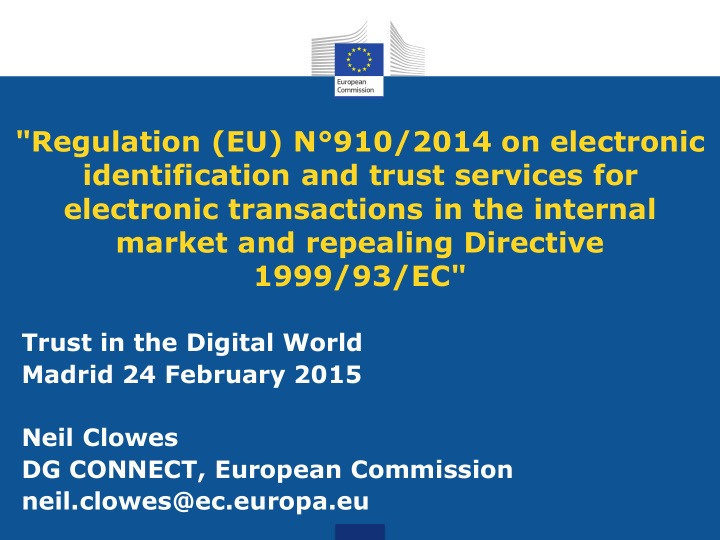



"Regulation (EU) N°910/2014 on electronic identification and trust services for electronic transactions in the internal market and repealing Directive 1999/93/EC" Trust in the Digital World Madrid 24 February 2015 Neil Clowes DG CONNECT, European Commission neil.clowes@ec.europa.eu
The eIDAS Regulation Strengthens EU Single Market by boosting trust and convenience in secure and seamless cross- border electronic transactions • - Mutual recognition of e-identification means • - Electronic trust services • - Electronic documents 2
Key principles Key principles on eID - Mandatory cross-border recognition only to access public services - Free of charge for public services - Acceptance relies on defined levels of assurance Key principles on trust services - Electronic trust services to have the same legal status as their paper equivalent - Technological neutrality 3
Timeline 2014 2015 2016 2019 2017 2018 17.09.2014 - Entry into force of the Regulation 18.09.2015 - Voluntary recognition eIDs 1.07.2016 - Date of application of rules for trust services 18.09.2018 - Mandatory recognition of eIDs 4 4
Planning of Implementing Acts: By 18.03.2015 MS cooperation for eID (art. 12.7) – Positive opinion in Committee on 14.01.2015 By 01.07.2015 EU Trustmark for QTS (art.23.3) By 18.09.2015 Interoperability framework for eID (art. 12.8) eID levels of assurance (art. 8.3) Trusted lists for QTSP (art.22.5) Formats of eSignatures (art. 27.4) Formats of eSeals (art. 37.4) - Additional IAs may also be adopted when appropriate (e.g. circumstances formats and procedures for the notification of eID - art. 9.5) 5
Messages from private sector event • - There is increasing business demand for trust, security and convenience in online transactions • - Reliability, simplicity and security - deciding factors in uptake-> mobile environment/diversity of credentials • - Public sector should lead by example • - Need for European interoperability supported by some standards-> federating eID & global dimension • - Govs and private sector need business model for provisioning and consuming eID means • - Cross-sector & cross-border use of eID calls for more regulatory alignment 6
Stakeholder's engagement activities A stakeholder plan is being developed eIDAS plays an important role in realising DSM Cross-sector take-up of eIDAS should be pushed Key sectors: e-Commerce, Financial & Payment Services, Banking, Tourism, Transport, Airline Operators, Telco Operators, Social Innovators Next relevant events: 24.02.2015: Digital for Europe Stakeholder Forum End of March 2015: 2 nd eID high level event 23.04.2015: EU Trust Mark ceremony Spring: Joint event on finance/banking (London) June 2015: ENISA's forum bringing together TSPs, CABs and SBs
An eIDAS World REGULATORY Implementi Expert ng & Comitology Group Delegated • acts Promote EU market CEF / DSI solutions TECHNICAL MARKET Negotiation eIDAS LSPs with 3rd Regulation countries Standardis Global ation industrial activities policy Awareness/ Engagement Communicati ENISA events on tools 8 STAKEHOLDERS' ENGAGEMENT
Recommend
More recommend